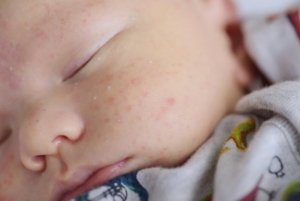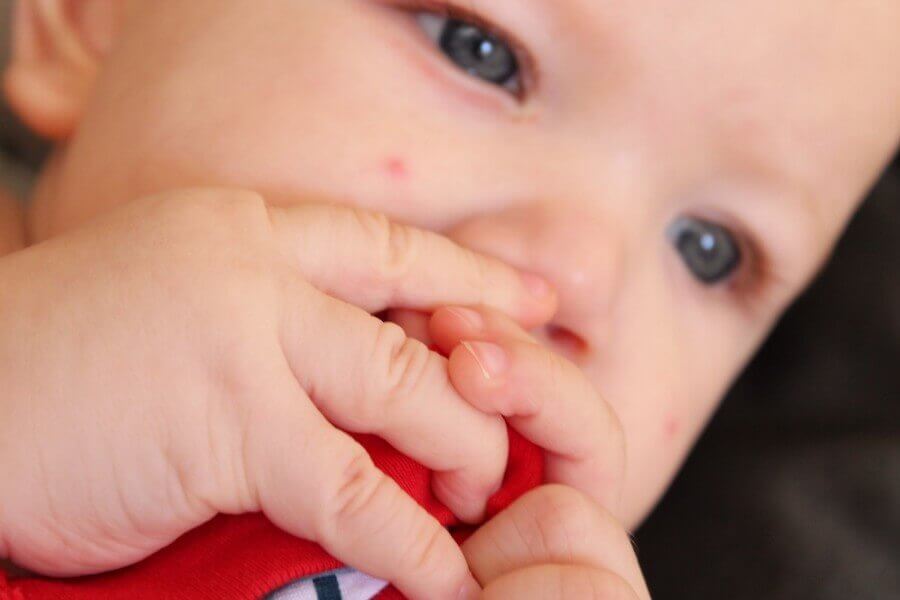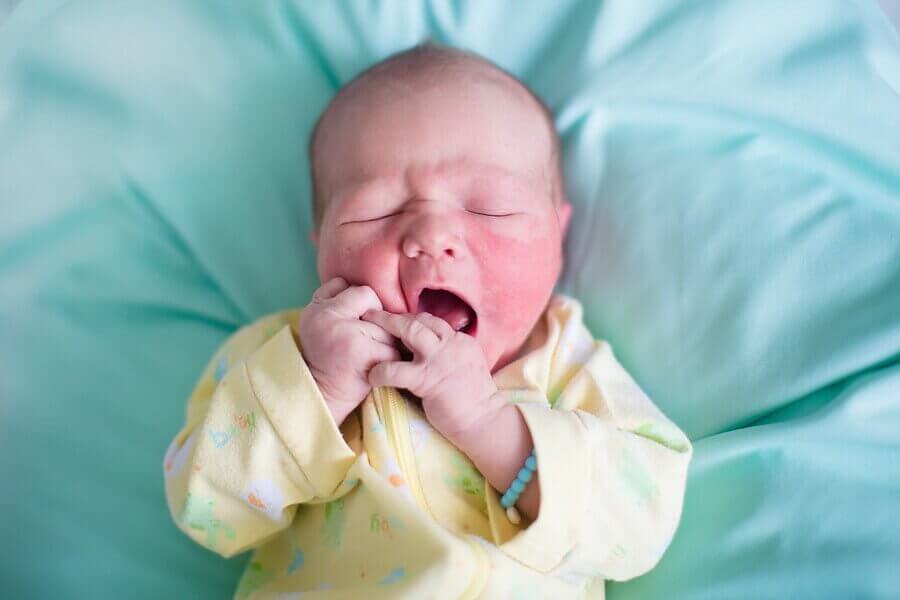Milia in Newborns: Causes, Symptoms and Treatment

Milia in newborns is a skin condition whose main characteristic is small white pimples or cysts. It’s a very common condition. In fact, 40% of babies develop these small pimples that contain keratinous material.
Milia in newborns
What is it?
Milia in newborns is a group of pearly or yellowish white pimples that commonly appear on the face. They’re generally about 1 or 2 millimeters in diameter. Specifically, they appear on babies’ cheeks, forehead and chin, as well as on the inside of their mouth.
Therefore, milia appears as small epithelial cysts that are filled with a keratinous substance. When squeezed, a small pearl-like substance pops out, which are formed by traces of keratinocytes. We should mention that you don’t need to do any tests to diagnose it.

What causes it?
Milia forms when epithelial cells in the skin are trapped in the small cavities on the surface. This causes the small, white pearly spots on their skin.
It’s common for parents to think it’s acne on their baby’s face. However, milia and acne are totally different conditions.
What are its effects?
Milia doesn’t cause effects. In fact, babies don’t feel any discomfort, nor do they feel pain of any kind.
These outbreaks don’t cause a fever, itching or any other type of complication. In addition, they also don’t require medical treatment.
Does it present any risks for newborns?
The first thing to keep in mind is that milia cysts are benign. In very rare situations, it can indicate some skin diseases. For example, it could be linked to Bazex-Dupre-Christol syndrome, Parry-Romberg syndrome, or Gardner syndrome.

How to treat milia in newborns
It’s very important to know that newborn skin is very delicate. Therefore, be extra careful to prevent spreading germs that could cause problems.
These are some things that you should keep in mind:
- Don’t rub or try to pop the pimples. This could damage your baby’s skin and leave scars.
- We advise cleaning the affected area with special soap for newborns.
- If milia develops when your child is older or develops in more sensitive areas, such as the mouth or eyes, it may take up to four months to disappear.
- If it doesn’t go away in three months, go to the pediatrician. He’ll tell you what to do.
Although most cases won’t require any specific treatment, it’s essential that you get a medical evaluation. This way, you can get a good diagnosis, and stay calm as parents.
In addition, you’ll avoid implementing unnecessary treatments that may actually be counterproductive for your baby.
Milia in newborns is a skin condition whose main characteristic is small white pimples or cysts. It’s a very common condition. In fact, 40% of babies develop these small pimples that contain keratinous material.
Milia in newborns
What is it?
Milia in newborns is a group of pearly or yellowish white pimples that commonly appear on the face. They’re generally about 1 or 2 millimeters in diameter. Specifically, they appear on babies’ cheeks, forehead and chin, as well as on the inside of their mouth.
Therefore, milia appears as small epithelial cysts that are filled with a keratinous substance. When squeezed, a small pearl-like substance pops out, which are formed by traces of keratinocytes. We should mention that you don’t need to do any tests to diagnose it.

What causes it?
Milia forms when epithelial cells in the skin are trapped in the small cavities on the surface. This causes the small, white pearly spots on their skin.
It’s common for parents to think it’s acne on their baby’s face. However, milia and acne are totally different conditions.
What are its effects?
Milia doesn’t cause effects. In fact, babies don’t feel any discomfort, nor do they feel pain of any kind.
These outbreaks don’t cause a fever, itching or any other type of complication. In addition, they also don’t require medical treatment.
Does it present any risks for newborns?
The first thing to keep in mind is that milia cysts are benign. In very rare situations, it can indicate some skin diseases. For example, it could be linked to Bazex-Dupre-Christol syndrome, Parry-Romberg syndrome, or Gardner syndrome.

How to treat milia in newborns
It’s very important to know that newborn skin is very delicate. Therefore, be extra careful to prevent spreading germs that could cause problems.
These are some things that you should keep in mind:
- Don’t rub or try to pop the pimples. This could damage your baby’s skin and leave scars.
- We advise cleaning the affected area with special soap for newborns.
- If milia develops when your child is older or develops in more sensitive areas, such as the mouth or eyes, it may take up to four months to disappear.
- If it doesn’t go away in three months, go to the pediatrician. He’ll tell you what to do.
Although most cases won’t require any specific treatment, it’s essential that you get a medical evaluation. This way, you can get a good diagnosis, and stay calm as parents.
In addition, you’ll avoid implementing unnecessary treatments that may actually be counterproductive for your baby.
All cited sources were thoroughly reviewed by our team to ensure their quality, reliability, currency, and validity. The bibliography of this article was considered reliable and of academic or scientific accuracy.
- Bagazgoitia, Lorea. (2016). Quistes de milium: esas bolitas blancas en la cara. Blog de Dermatología
- C. Ribes Bautista. Recién nacido: lesiones cutáneas benignas transitorias. F. A. Moraga Llop. http://www.enfermeriaaps.com/portal/download/DERMATOLOGIA/rn_benignastransitorias_0.pdf
This text is provided for informational purposes only and does not replace consultation with a professional. If in doubt, consult your specialist.








